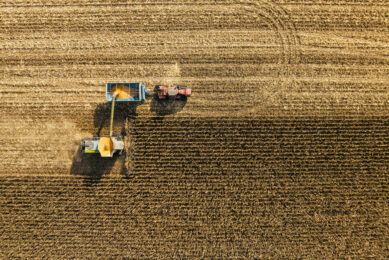Autonomous tractor – ‘No problem leaving it to work alone’

Swinkels Groenten in the Netherlands recently conducted a trial with the autonomous Fendt 716 tractor, equipped with the iQuus system, as part of the National Fieldlab for Precision Farming (NPPL) initiative. The farm, which cultivates around 150 hectares of crops, including leeks, cauliflower, sugar beets, and cover crops, sees potential in using autonomous machinery to boost efficiency, particularly for tasks such as weeding and soil preparation.
Swinkels Groenten, a participant in the National Precision Agriculture Field Lab (NPPL), worked with the autonomous Fendt 716 in the week of July 15. The tractor, equipped with the iQuus system, can work unmanned. The Fendt tractor was used to till cover crops (Japanese oats) and prepare a field for planting cauliflower. This practical test was more extensive than last year’s with a modified MF tractor.
Quick to learn
“It’s going well. It works,” said crop worker Aswin Dierx. “If you’re familiar with GPS and headland management, you’ll quickly get the hang of this system.” One challenge, however, is that you have to manually drive around the field’s corners beforehand. “But if we owned the system, all the field data would already be stored.” For fields of around two hectares or more, Dierx believes the system is very promising.
Initial issues like steering problems were quickly resolved remotely. When the tractor’s obstacle detection system mistakenly identified tall oats as a barrier, they adjusted the sensor’s position. “Nothing unusual when using such a tractor for the first time. We have no problem setting it to work and walking away.”
Text continues below picture

Obstacle detection challenges
On July 23, the front camera unexpectedly stopped the tractor in an empty field, detecting dust as an obstacle. Dierx communicated the issue via WhatsApp with GPX Solutions, the system provider, and they confirmed they are working on resolving dust detection issues.
Aswin sends a video of the tractor suddenly stopping in the middle of the field, with the message: “Seems unlikely that it found an obstacle here.”
Supplier: “Is the bumper plug still properly connected?”
Aswin: “Yup. I think it’s seeing the dust. It keeps doing it.”
Supplier: “That could be it. We’re working on a fix to keep it moving through dust. Is the dust blowing high above the ground?”
Aswin: “No, just into the air.”
Supplier: “Then raising the bumper a bit won’t help. Is it working better on the headlands?”
Aswin responds to the update about ongoing work: “That would be great. The difference between wet conditions and dust here is often very small.”
Supplier: “It’s a priority at the moment.”
Aswin: “I started it up this afternoon, had to go over twice because it gave the steering error again. Seemed like nothing serious, just clicked start again and it kept going. But now with the dust, it keeps stopping, so I’m finishing it up myself.”
Need for larger headlands
For now, one issue is that the demonstration tractor cannot reverse due to the lack of a safety feature at the rear. As a result, the tractor needs a much larger headland than the five meters used at Swinkels to turn around. The automation system calculates a fifteen-meter-wide strip around the entire field, not just at the ends of the rows.
“What we don’t want is to prepare the entire field first and then only start planting. That would mean we’d still have to get on the tractor from time to time to manually handle the headland. The same concern applies to weeding. If the tractor can’t turn on our fixed five-meter headland, it will damage too many crops while turning.” Later, it was found that working with a smaller headland is possible. Aswin said: “Now, with a ten-meter headland, it just manages to turn without driving off the field.”
The iQuus supplier has already informed Swinkels that a reversing option is possible. For that, a frame would need to be made for each implement behind the tractor. A front PTO is also desirable. Dierx explained: “Now we have to till the Japanese oats twice. If we had been able to mow them first with a front PTO, it would have saved an extra pass.”
Text continues below picture

Efficient fuel use
One advantage of the automated system is its ability to maintain the most efficient fuel consumption. “Unlike a human driver, the tractor doesn’t press the gas pedal to finish faster,” Dierx noted. “An extra hour of work is no problem.”
Future Potential
Swinkels sees potential in using the tractor, especially since it can be operated manually when needed. They suggest adding a front camera to remotely identify obstacles and reduce downtime.
Swinkels’ tractors use Trimble for GPS, while iQuus runs on Raven. Dierx believes using existing Trimble systems could cut costs by half if they decide to adopt the technology.
Join 17,000+ subscribers
Subscribe to our newsletter to stay updated about all the need-to-know content in the agricultural sector, two times a week.



